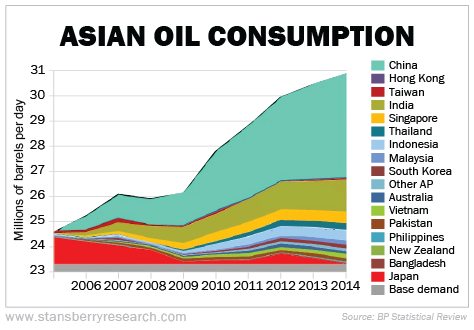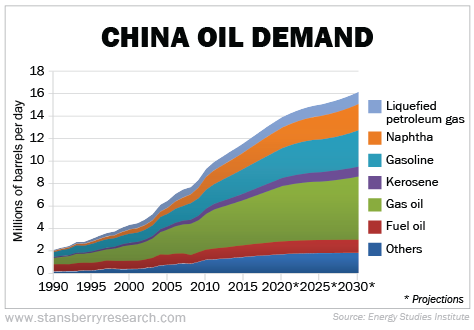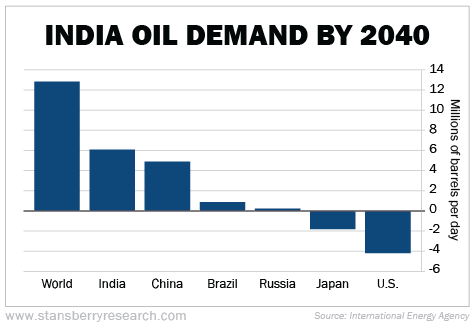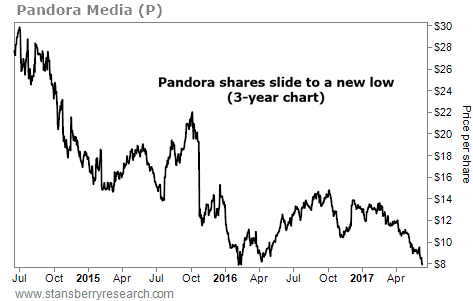| Home | About Us | Resources | Archive | Free Reports | Market Window |
|
Editor's note: The headwinds facing oil prices are clear. Even Steve recommended betting against oil for the short term back in March. But our in-house resource guru, Flavious Smith, believes oil prices won't stay down for long.
In today's essay, he explains why two of the world's largest countries will send demand – and prices – soaring to unimaginable heights in the years to come...
Two Emerging World Powers Will Change the Oil Industry ForeverBy
Wednesday, June 14, 2017
Don't be fooled...
When things look bad, it's hard to imagine anything changing.
Oil prices have been crushed. But the world is about to experience a huge shift. It's already starting. And I believe it's going to turn things around for the oil industry – in a big way...
Yesterday, I told you the U.S. is the largest oil consumer on the planet.
Japan uses a lot of oil, too. And again, given our high standards of living, that shouldn't come as a surprise.
But zoom out and you realize that the total population of both countries is only around 450 million people – around 6% of the world's population.
Meanwhile, China has a population of nearly 1.4 billion. It uses 4 billion barrels of oil per year – about 11 million barrels per day.
In other words, the U.S. – with a population about one-fifth the size of China – consumes almost two times more oil.
But here's the kicker...
China is in the middle of another industrial revolution. Poverty is decreasing, and the middle class is growing. The standard of living is on the rise. The Chinese are driving cars and scooters, watching TV, using a lot of electricity, and making a lot of stuff.
By next year, China is set to overtake the U.S. as the world's largest importer of crude oil.
The following graphic shows how much oil consumption grew from 2005 through 2014 in many countries around the world...
 China's economy has grown 900% since 1999. Over that period, it has grown to be the world's second-largest economy at more than $10 trillion. Instead of bicycles crowding the streets, the Chinese are driving cars and scooters. Vehicle sales have exploded, and demand for oil has nearly tripled in the last 20 years alone. And as you can see from the following chart, it's still growing...
 Note the increase in gasoline demand since 2005. This is an early indicator of more demand to come from the mobilization of China's nearly 1.4 billion people. But if this looks promising, you ain't seen nothing yet...
For as big of a catalyst as China will be for oil prices, India has even more potential to move the needle.
There are around 1.3 billion people in India... around three times the combined population of the U.S. and Japan. India uses 1.5 billion barrels of oil per year, or about 4.1 million barrels per day.
That's just a fraction of the oil used in China. But India is expected to add another 241 million "people of working age" by 2030. And you can bet that most of them will be driving cars, watching TV, and making stuff. Soon, India will pass China to become the world's highest-populated country.
Because of that, India is expected to be the fastest-growing consumer of crude oil in the world through 2040, adding 6 million barrels a day of demand (versus 4.8 million barrels a day for China)...
 Three main catalysts will drive oil demand higher in India...
China and India's combined population is 2.7 billion people. What happens when 2.7 billion people begin to use oil at the rate of the U.S. and Japan?
See where this is going?
Today, the U.S. and Japan use about 19 barrels of oil per person per year. Even if China and India consume just five barrels of oil per person per year by 2030, that amounts to more than 13 billion barrels of oil... increasing world demand by more than 9 billion barrels per year.
The pullback in oil prices since 2014 has beaten down most exploration and production companies – the ones that drill the wells and produce the oil and gas. But with demand in China and India set to explode, oil prices may never be this low again.
Good investing,
Flavious Smith
Further Reading:
"As resource investors, we must always be looking for value," Flavious writes. You hear nothing but bad news for the oil industry today... But that's exactly why we need to start paying attention. Learn more here: Despite the Headwinds, Oil Prices Are Heading Much, Much Higher.
"Some of the biggest winners over the next few years likely won't be here at home... They'll be in emerging markets," Steve writes. When emerging markets take off, they can absolutely soar. And right now, the signs are telling us to get on board. Learn more here: Why You Need to Move Money OUT of the U.S. Today.
Market NotesA BUSINESS STRUGGLING TO KEEP UP Today, we take a look at a once-popular company fighting to keep its head above water...
Pandora Media (P) was one of the first music-streaming providers on the Internet. The service selects music and creates custom playlists based on its users' favorite bands and musicians. The business quickly took off.
But since then, Pandora's management team has made several blunders. The vast majority of its 80 million monthly users pay nothing to listen. In March, Pandora launched a $9.99-per-month updated premium service. But in the meantime, competitors Spotify and Apple Music have made full use of their paid plans and gobbled up huge chunks of the music-streaming industry.
All of this has dragged on Pandora's bottom line. The company has reported its listenership has fallen in each of the last three quarters, while its competitors continue to rapidly grow their market shares. As a result, the stock has plummeted, falling around 70% over the last three years to its lowest level since late 2012. Unless Pandora manages to turn things around quickly, this once-popular stock will continue its freefall...
 |
Recent Articles
|



